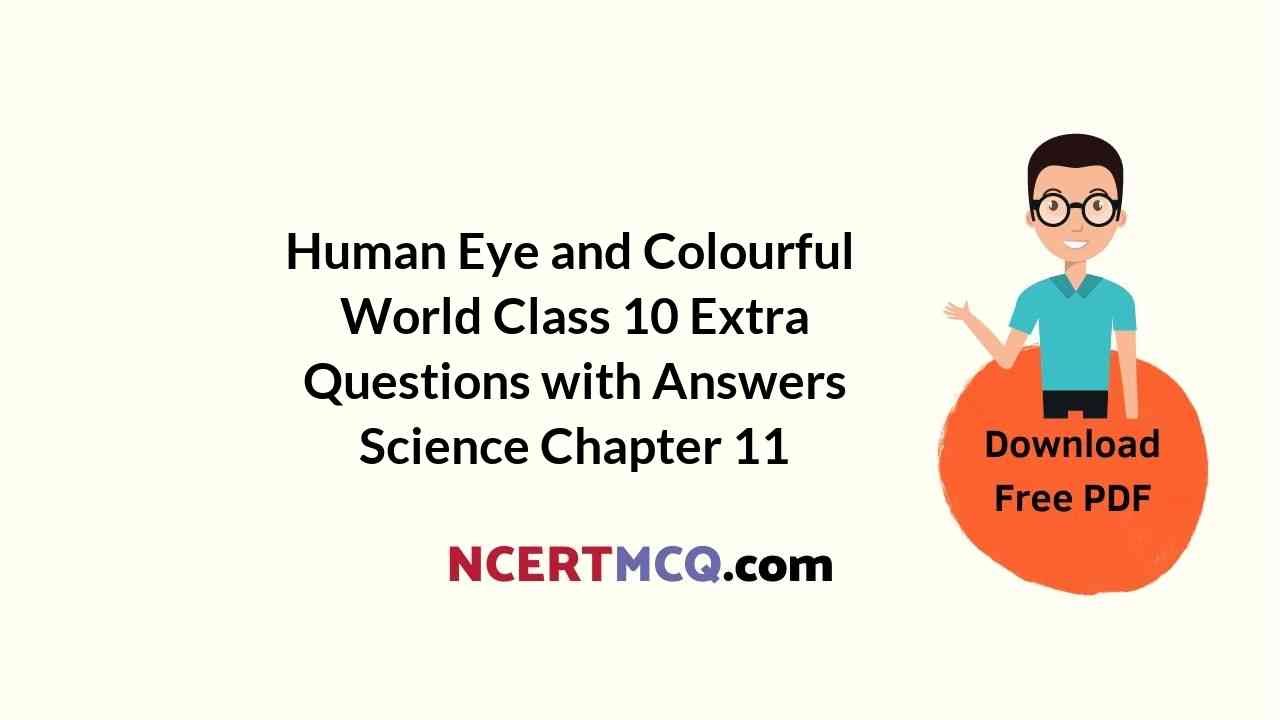In this page, we are providing Human Eye and Colourful World Class 10 Extra Questions and Answers Science Chapter 11 pdf download. NCERT Extra Questions for Class 10 Science Chapter 11 Human Eye and Colourful World with Answers will help to score more marks in your CBSE Board Exams. https://ncertmcq.com/extra-questions-for-class-10-science/
Class 10 Science Chapter 11 Extra Questions and Answers Human Eye and Colourful World
Extra Questions for Class 10 Science Chapter 10 Human Eye and Colourful World with Answers Solutions
Extra Questions for Class 10 Science Chapter 11 Very Short Answer Type
Class 10 Science Chapter 11 Extra Questions Question 1.
Why is the colour of the clear sky blue? (NCERT Exemplar)
Answer:
Colour of the clear sky is blue: The molecules of air and other fine particles in the atmosphere have size smaller than the wavelength of visible light.
When sunlight passes through the atmosphere, the fine particles in air scatter the blue colour more strongly than red.
Human Eye And The Colourful World Class 10 Extra Questions And Answers Question 2.
Why do stars appear to twinkle?
Answer:
Stars appears to twinkle due to atmospheric refraction.
Human Eye Class 10 Extra Questions Question 3.
Define farthest point of an eye.
Answer:
Farthest point of an eye: The farthest point upto which the eye can see objects clearly is called far point of the eye. It is infinity for normal eye.
Human Eye And Colourful World Extra Questions Question 4.
Define power of accommodation.
Answer:
Power of accommodation: The ability of the eye lens to adjust its focal length is called accommodation.
Human Eye And The Colourful World Extra Questions Question 5.
Define least distance of distinct vision.
Answer:
Least distance of distinct vision: Minimum distance at which an object can be seen distinctly without any strain from the normal eye, i.e., 25 cm for normal vision.
Human Eye And Colourful World Class 10 Extra Questions Question 6.
Define Tyndall effect.
Answer:
Tyndall effect: The phenomenon of scattering of light by colloidal particles gives rise to Tyndall effect.
Tyndall effect can be observed when sunlight passes through a canopy of a dense forest. Here tiny droplets in mist scatters light.
Class 10 Science Ch 11 Extra Questions Question 7.
Define atmospheric refraction.
Answer:
Atmospheric refraction: If physical conditions of the refracting medium (air) are not stationary, the apparent position of the object fluctuates.
Extra Questions Of Human Eye And The Colourful World Question 8.
Why are danger signal lights red in colour?
Answer:
Danger signal lights are red in colour because red colour is least scattered by fog or smoke.
Extra Questions for Class 10 Science Chapter 11 Short Answer Type I
Cbse Class 10 Physics Human Eye And Colourful World Extra Questions Question 1.
What is meant by advance sunrise and delayed sunset? Draw a labelled diagram to explain these phenomena.
Answer:
Advance sunrise and delayed sunset is due to atmospheric refraction.
When the sun is slightly below the horizon, the sunlight coming from the less dense (vacuum) to more dense (air) medium is refracted downwards. So the sun appears to be above the horizon.
Similarly, even after actual sunset, the sun can be seen for a few minutes due to refraction of sunlight.
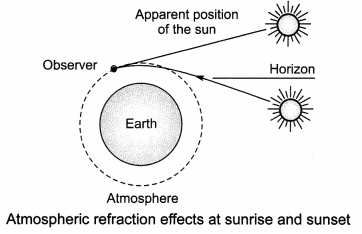
Class 10 Human Eye Extra Questions Question 2.
Explain formation of rainbow.
Answer:
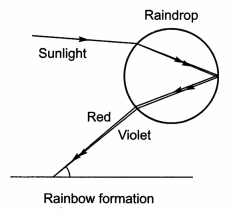
Rainbow formation: A rainbow is a natural spectrum appearing in the sky after rain shower. It is caused by dispersion of sunlight by tiny water droplets, present in the atmosphere. The water droplets act like small prism. They refract and disperse the incident sunlight, then reflect it internally and finally refract it again.
Due to dispersion of light and internal reflection different colours appear.
Chapter 11 Science Class 10 Extra Questions Question 3.
Explain the refraction of light through a triangular glass prism using a labelled ray diagram. Hence define the angle of deviation. (NCERT Exemplar)
Answer:
Refraction of light through prism
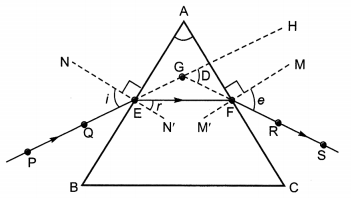
PE – Incident ray
EF – Refracted ray
FS – Emergent ray
∠A – Angle of the prism
∠i – Angle of incidence
∠r – Angle of refraction
∠e – Angle of emergence
∠D – Angle of deviation
Refraction of light through a triangular glass prism
- The refraction of light takes place at two surfaces firstly when light enters from air to prism and secondly when light emerges from prism.
- Angle of prism: The angle between the two lateral faces of the prism is called angle of prism.
- Angle of deviation: The angle between incident ray (produced forward) and emergent ray (produced backward).
Extra Questions for Class 10 Science Chapter 11 Short Answer Type II
Human Eye And The Colourful World Class 10 Questions And Answers Question 1.
What is the difference in colours of the sun observed during sunrise/sunset and noon? Give explanation for each.
Answer:
In the morning and evening, the sun lies near the horizon. Sunlight travels through a larger distance in the atmosphere and most of the blue light and shorter wavelengths are scattered away by the particles. Therefore, the light that reaches our eyes is of longer wavelength. This gives rise to the reddish appearance of the sun.
At noon sun appears white as only a little of blue and voilet colours are scattered.
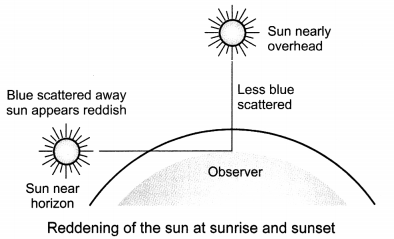
Extra Questions Of Chapter 11 Science Class 10 Question 2.
Define the term dispersion of white light. Name the colour of light which bends (i) the most, (ii) the least, while passing through a glass prism. Draw a ray diagram to justify your answer.
Answer:
Dispersion of white light by a glass prism
Dispersion: The splitting of light into its component colours is called dispersion.
The red light bends the least while violet bends the most.
Spectrum: The band of the coloured components of a light beam is called spectrum.
i.e., VIBGYOR
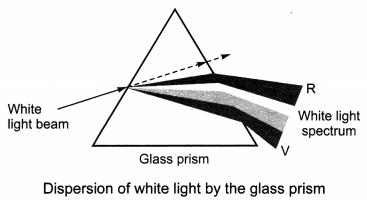
The Human Eye And The Colourful World Extra Questions Question 3.
Explain twinkling of stars.
Answer:
Twinkling of stars:
- The twinkling of stars is due to atmospheric refraction of starlight.
- When starlight enters the earth’s atmosphere, it suffers refraction continuously. Since the physical conditions of the earth’s atmosphere are not stationary the stars appear twinkling.
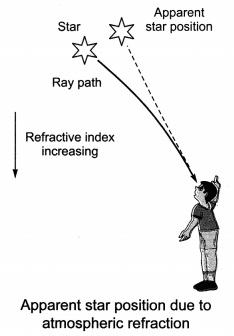
Extra Questions for Class 10 Science Chapter 11 Long Answer Type
Human Eye And Colourful World Class 10 Questions With Answers Question 1.
List four common refraction defects of vision. Suggest the way of correcting these defects. (CBSE 2014)
Answer:
Defects of vision:
(i) Cataract: Crystalline lens of people at old age becomes milky and cloudy. This condition is called cataract.
It is possible to restore vision through cataract surgery.
(ii) Myopia: (Near sightedness)
A person with myopia can see nearby objects clearly but cannot see distant objects clearly.
Cause:
- Due to excessive curvature of the eye lens.
- Elongation of the eyeball.
Correction:
Concave lens of suitable power.
(a) Far point of myopic eye
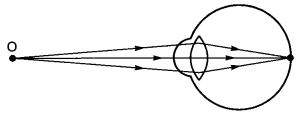
(b) Myopic eye

(c) Correction for myopia

(a), (b) The myopic eye, and (c) correction for myopia with a concave lens
(iii) Hypermetropia (far-sightedness)
A person with hypermetropia can see distant objects clearly but cannot see nearby objects distinctly.
Cause:
- The focal length of the eye lens is too long.
- The eyeball has become too small.
Correction:
Convex lens of suitable power.
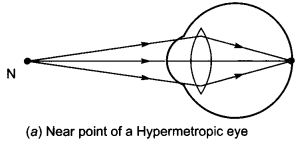
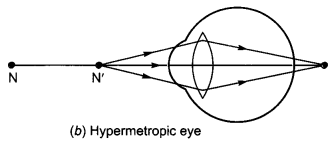
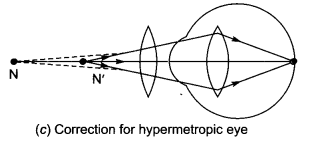
(a), (b) The hypermetropic eye, and (c) correction for hypermetropia
(iv) Presbyopia
The power of accommodation of the eye usually decreases with ageing. In this eye defect it is difficult to see nearby objects comfortably and distinctly without corrective eye glasses.
Cause:
Weakening of ciliary muscles and diminishing flexibility of eye lens.
Correction:
By using Bifocal lens: Upper portion consists of concave lens and lower part is convex lens.
Question 2.
Explain the structure and functioning of the human eye. How are we able to see nearby as well as distant objects?
Answer:
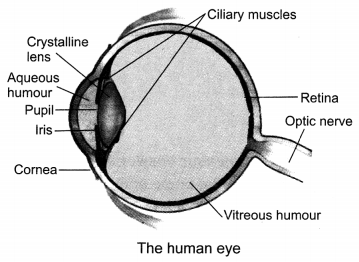
- Cornea: A thin membrane through which light enters the eye, maximum refraction occurs at the outer surface of cornea.
- Iris: A dark muscular membrane which controls size of pupil.
- Pupil: Regulates and controls the amount of light entering the eye.
- Eye lens: Composed of fibrous, jelly like material, with adjustable curvature, forms an inverted and real image of object at retina.
- Retina: It is a light sensitive screen on which image is formed.
The power of accommodation, that is, the ability of the eye lens to adjust its focal length, help us to see near and far objects clearly.
Human Eye and Colourful World HOTS Questions With Answers
Question 1.
How will you use two identical prisms so that a narrow beam of white light incident on one prism emerges out of the second prism as white light? Draw the diagram.
Answer:
When an inverted prism is kept a little distance away from the prism causing dispersion or basically in the path of splitted beam, the spectrum recombines to form white light.
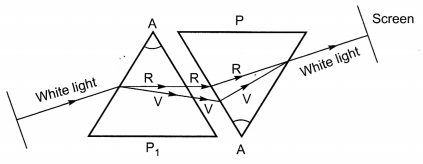
Recombination of the spectrum of white light
Question 2.
Is the position of a star as seen by us in its exact position? Justify your answer. (NCERT Exemplar)
Answer:
No, the starlight, on entering the earth’s atmosphere, undergoes refraction continuously before it reaches the earth. The atmospheric refraction occurs in a medium of gradually changing refractive index. Since the atmosphere bends starlight towards the normal, the apparent position of the star is slightly different from its actual position.
Question 3.
Why do we see a rainbow in the sky only after rainfall?
Answer:
The rainbow in the sky appears only after rainfall because the suspended water drops behave like prism, and refract, disperse and reflect the light rays internally.
Question 4.
A person needs a lens of power – 4.5 D for correction of his/her vision.
(a) What kind of defect in vision is he/she suffering from?
(b) What is the focal length of the corrective lens?
(c) What is the nature of the corrective lens?
Answer:
(a) Myopia
(b) f = \(\frac{1}{P}\) = \(\frac{100}{4.5}\) = 22.2 cm
(c) Concave lens
Question 5.
A narrow beam PQ of white light is passing through a glass prism ABC as shown in the diagram. (CBSE 2014)
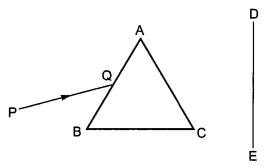
Trace it on your answer sheet and show the path of the emergent beam as observed on the screen DE.
(i) Write the name and cause of the phenomenon observed.
(ii) Where else in nature is this phenomenon observed?
(iii) Based on this observation, state the conclusion which can be drawn about the constituents of white light.
Answer:
(i) Dispersion of light, because different colours of light bends through different angles.
(ii) Rainbow formation
(iii) White light contains seven colours i.e., VIBGYOR
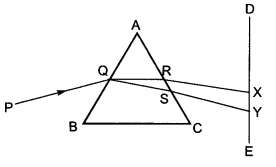
Question 6.
On which factor does colour of scattered light depends?
Answer:
The colour of the scattered light depends on the size of the scattering particles. Very fine particles scatter mainly blue light while particle of larger size scatters light of longer wavelengths.
Extra Questions for Class 10 Science Chapter 11 Value Based Questions
Question 1.
Akshay, sitting in the last row in his class, could not see clearly the words written on the blackboard. When the teacher noticed it, he asked if any student sitting in the front row would volunteer to exchange his seat with Akshay. Salman immediately agreed to exchange his seat with Akshay. Akshay could now see the words written on the blackboard clearly. The teacher thought it fit to send message to Akshay’s parents advising them to get his eyesight checked.
In the context of the above event, answer the following questions:
(a) Which defect of vision is Akshay suffering from? Which type of lens is used to correct this defect?
(b) State the values displayed by the teacher and Salman.
Answer:
(a) Myopia, concave lens
(b) Teacher is very caring and knowledgeable. Salman has great concern for his friend, Akshay, and is very helpful.
Question 2.
On the rainy day, Ram reached his grandfather’s place in village. On the way to the house he saw a beautiful rainbow in the sky. In the night, he saw lots of twinkling stars in the clear sky. He was very excited to see these beautiful natural phenomenon, which he was not able to see in the city, where he lived with his father. Explain the phenomenon on the basis of science. Do you think that pollution in the atmosphere affects the formation of rainbow and twinkling of stars. Do you agree with the fact that pollution free environment will strengthen such natural phenomenon in the cities as well. Elaborate.
Answer:
- The twinkling of star is due to atmospheric refraction.
- The formation of rainbow is due to dispersion, refraction and internal reflection.
- Yes, pollution in atmosphere affects the formation of rainbow and twinkling of stars.
Question 3.
Vinay’s father cannot read a book placed 25 cm from his eye. But he feels a little comfortable when the book is placed 50 cm away. Vinay adviced his father for checkup of the eyes.
(a) From which defect of vision Vinay’s father may be suffering from? Give the proper correction.
(b) State the values of Vinay.
Answer:
(a) Hypermetropia, correction can be done by using suitable convex lens.
(b) Vinay is caring and intelligent.
Question 4.
Ankit’s grandma is facing a problem of clouded, blurred and dim vision. Ankit took her to the doctor.
(a) From which defect of vision Ankit’s grandma may be suffering from? Give proper correction.
(b) State the values of Ankit.
Answer:
(a) Cataract. It is possible to restore vision through cataract surgery.
(b) Ankit is caring and intelligent.
